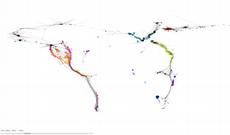Animation of bird migration
As part of an assignment, an ETH architecture student visualized bird migrations. The animation recreates the amazing seasonal movements of these animals.

Every autumn, millions of migratory birds leave the northern hemisphere to spend the winter in warmer areas in the southern hemisphere. They cover vast distances, sometimes from the North Pole to the South Pole and back - a natural spectacle that fascinated people since time immemorial.
This also fascinated Nicolás Miranda. The student of the Master of Advanced Studies in Architecture and Information (MAS AI) at ETH analysed the migrations of six species of migratory birds as a project of the second module of the MAS course. The result is an animation that accentuates the amazing journey of these birds.
From southern South America to Alaska
The short film shows in fast motion when and where birds fly through and where they stay for longer periods of time. The birds, however, are only visible as colored dots that move according to a time factor on a world map. These points migrate sometimes from the southernmost point of South America to Alaska, and from South Africa to Central or Northern Europe. Resting areas and wintering grounds are shown as areas with dense flying patterns while the flyways of the birds can be seen as thiner lines.
"Fly away ...", as Nicolás named his presentation, is based on data collected during 17 years, using satellite transmitters. Data were stored in the database www.movebank.org. For its visualization, Nicolás analysed about 600,000 data points of 193 different bird individuals. He coded the data and programmed algorithms, which allowed him to make visible the pattern of migratory movements.
Comparable networks
Nicolás Miranda's "fly away ..." is part of the Atlas of Networks, in which he and his fellow students were working as part of the "Programming" module of the MAS AI. With the Atlas, the architects explored various complex networks, which were graphically represented. This way, they looked for ways of visualization and simulation of networks starting from big amounts of data, in order to make them comparable.
Nicolás Miranda studied at the University of Chile, where he gained his
master's degree in architecture in 2009. In the past two years, he worked as an
architect in Basel, becoming last September a postgraduate student in
Architecture and Information (AI MAS) at the ETH Zurich.







READER COMMENTS